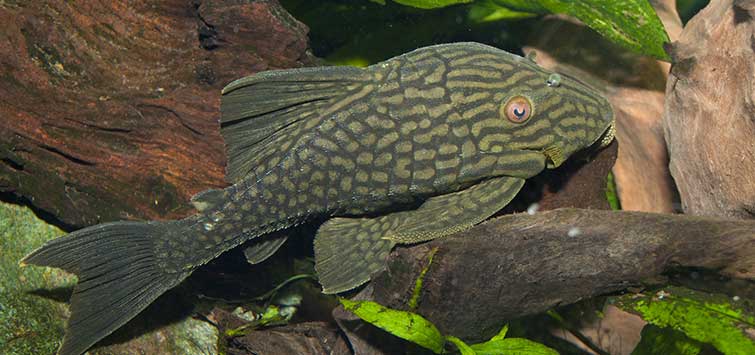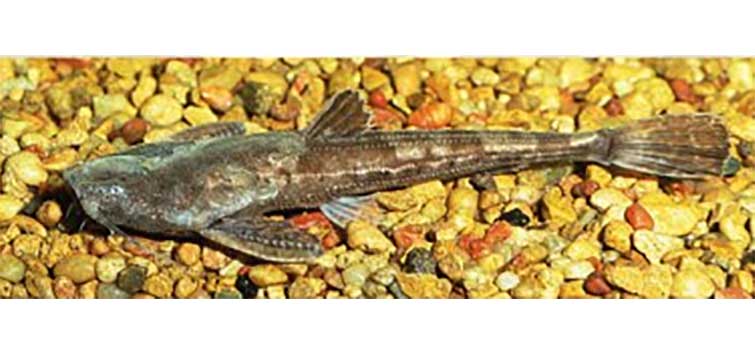Catfish Corner: Xylophages and Banjophiles
Author: Lee Finley
The topic of xylophagus (wood eating) catfishes is an interesting one, and some new information on this is currently in press and should be available by the time this column is in your hands.
Xylophagus Catfish Basics
I will first back up a bit for those readers who might not be familiar with this very interesting method of feeding. It has been known for some time, both by hobbyists and scientists, that certain South American members of the catfish family Loricariidae (plecos) regularly feed on wood and utilize this unusual food source for both body maintenance and growth. Most notable among these catfishes are members of the genus Panaque. This includes both the larger members of the genus (i.e., royal pleco P. nigrolineatus) and the smaller ones such as P. maccus (commonly sold as a clown plecos). There are also some members of the genus Hypostomus that have, in varying degrees, the same dietary preferences. These wood eating Hypostomus were previously placed in their own genus Cochliodon, which is now considered a synonym of Hypostomus.
All of these wood-eating loricariids have a number of features that allow them to successfully go about their lifestyle. The first of these is the presence of a small number of strong and specialized spoon-shaped teeth, which are able to rasp away fragments of wood that are then swallowed. Once these are in the digestive tract, they are met by a complex flora and fauna of fungi and bacteria that work to break down the wood into nutritionally useful materials for the catfish. These catfishes are the only known vertebrates that are able to live and thrive on such a diet.
In the forthcoming study “Dietary histories of herbivorous loricariid catfishes: evidence from d13C values of otoliths” by H. Nonogaki, J. A. Nelson, and W. P. Patterson—to be published in the journal “Environmental Biology of Fishes”—some interesting observations are made on the diet and feeding of Panaque nigrolineatus. The wild specimens of this “species” used in the study were collected during the dry season in the Rio do Peixe, Goias, Brazil. I use species in quotation marks in that “P. nigrolineatus” is in fact a widespread complex of species, and until this situation is worked out, the use of the specific name is basically a matter of convenience. With all of the variation that is known, coupled with the fact that P. nigrolineatus was originally described from specimens collected in Venezuela, I feel comfortable in stating that the Rio do Peixe fish will someday have its own name. For now it is known to be a variant of the DATZ L number 27; in the Aqualog L numbering system, this fish has been designated as L27C.
The “Canoe Eaters”
In any case, as far as it is known, all members of the genus Panaque are wood eaters. This is known equally well by scientists, aquarists, and the local human inhabitants in the areas where these fishes live. My friend Shane Linder has noted that in South America the common names given to these fishes are often indicative of the diet. Two such names mentioned by Shane include coma-canoa (canoe-eater) and runa-canoa (canoe-destroyer).
Although there are capture and underwater observations from the wild noting that Panaque species are found almost exclusively around sunken trees (or parts thereof) very little has been written in regards to the specific types of wood involved. Now, in regards to the Rio do Peixe Panaque, some such information is available. Although there were several species of sunken wood available in the habitat where the catfish were collected, they were found foraging exclusively on one species of coconut palm Scheelea phalerata. This is a widespread species and might well be a preferred food for Panaque when it is available, but I would strongly suspect that other tree species would be included in the diet of the Panaque species throughout their range. In any case, the outside of this tree is quite hard, so it is the insides (starting at broken off areas) that are eaten. The end effect is basically hollowed out sections of tree.
The stomach contents of the captured fish were looked at and it was noted that the “…only apparent” contents were wood shavings. It is also noted, unfortunately, that a full assessment of the gut contents was not made. Such an examination would have been very interesting. While there is no question that wood was the primary food source, the knowledge of additional food items would have been nice to know and would have added information to the basic biological knowledge of the fish.
Many Hypostomus species (the non-wood feeders) are generally noted to be algae eaters, but with the few that have been comprehensively studied, additional food items such as insect larvae and other invertebrates have been found to be present in at least modest numbers (plus or minus 10 percent). I would suspect that such items would also potentially be present in the gut of Panaque species in that, as they are a part of the biocover that develops on sunken wood, they would be taken as a part of the wood grazing process. Depending on ambient conditions and the time the wood has been submerged, one would also suspect at least a partial covering of algae that would also be ingested as a part of the grazing process. It will be interesting to see if future studies on the diet of Panaque species bear this out.
Woods for the Aquarist
For quite some time aquarists have observed that the given volume of most woods present in a tank with Panaque spp. will decrease over time. This can be rather quickly with larger species such as the P.nigrolineatus group, and a bit slower with some of the smaller species.
What kind of woods would be good for feeding to these xylophagous species? Some experimentation in regards to this has been reported, and I would like to add some comments on this.
Feeding Experiments
As part of a study on dietary preferences with one of the small Panaque species (P. maccus), Toba Niazi experimented with material from four different trees. These were eastern white pine Pinus strobus, black walnut Juglans nigra, black birch Betula lenta, and red maple Acer rebrum.
Each wood type was divided into two groups, one with the phloem exposed and one with the xylem exposed. Here we need to revert to a little basic botany. The phloem is closer to the surface (in or near the bark) and is the part of a vascular plant that distributes the products of photosynthesis (carbohydrates, etc.). The xylem is located deeper within the wood and has the main function of the distribution of water. Niazi found that P. maccus much preferred to eat the outer phloem layer on all four species of wood. If given options, the softer Eastern pine was consistently preferred as food over the other three species. This is interesting in light of the observations on the Rio do Peixe “P. nigrolineatus,” which also seemed to prefer the softer available parts of the palm. In any case, a good number of the P. maccus in the study did gain weight with the woods as the only food being available.
Try for Yourself
I think that this wood feeding, based on the above results, is well worth experimentation by aquarists. (In addition to the noted woods, I have also seen discussions of apple wood being eaten.) In that the catfish do seem to prefer the outer layers (bark and slightly below) of the wood, it would probably be best to replace the food source as necessary, as opposed to making them eat the whole piece. And, of course, know the origin of your wood. Do not collect in any place where there is even the most remote chance that any spraying might have taken place. Also, wash the wood very well, and it might also be advisable to submerge and soak it for a while.
With all of the above in mind, don’t ignore or skimp on other vegetal foods in the captive diet of Panaque spp. This can include numerous fresh vegetables (raw, or better yet, lightly boiled) such as zucchini, broccoli, yellow squash, etc. Also, make sure to use one or more commercial foods that are high in algae or other vegetal materials (read the label!). These are fortified with various vitamins and minerals and should be considered a mandatory addition to the diet (think of them as you would supplements for your own diet).
In Praise of Little Brown Fish
Catfishes such as the above-discussed P. nigrolineatus (L27) get a lot of print. But catfish fans, either early on or later, often come to appreciate some of those species that may not be so attractive. Such is a case that I have been able to observe as of late.
Recently my home club, the Tropical Fish Society of Rhode Island, held its Sunday auction in conjunction with our annual show. As usual, some outstanding catfishes were available: Synodontis petricola, Scleromystax barbatus, Hypancistrus inspector, and a bucket containing four large Mystus leucophasis (Asian upside-down catfish). I took the Mystus home!
Amanda Parker, a friend and club member, has been increasingly expanding her catfish collection. The auction served her well, and she won the bid on a bag of real nice little Scleromystax barbatus. During the auction flow she also took the bid on a bag of two banjo catfishes Bunocephalus sp. These were brown and lethargic (that is what they are and how they act).
By the next day Amanda had proudly posted some photos of the Scleromystax on the website PlanetCatfish.com, but rather quickly her attention was diverted to the little brown banjos. She started observing their behavior of burying themselves in the gravel and tried to figure out when they were coming out to eat. From some of her emails and posts, I get the impression that she was loosing sleep by staying up after lights-out to see what they would do. I know that she really likes the S. barbatus, but I get the impression that she loves the little brown banjos. Will they spawn someday? Who knows? Who cares? They have caught the heart of a true catfish fan—and what more could any little brown catfish ask?

.png?h=595&iar=0&w=2781&hash=5FD5E69473BCC22199FBFA2FB71B6033)



